
Miami New Times images/Photos by Carlos Serrao

Audio By Carbonatix
Welcome to “Flashback,” a recurring – perhaps even monthly; we’ll see how that goes – feature wherein we turn back the Miami New Times pages and sift through the archives to see what was shaking 30 years ago, then dust it all off to examine it in the harsh light of today.
By 1995, New Times had already been around awhile, having published its first issue in December of 1987. According to the staff box in the January 5-11 issue, the paper boasted a full-time editorial department staff of 19, including nine reporters and two copy editors. (Also of particular note: upstart art director Brian Stauffer, who designed all the cover and feature layouts below and is now a highly sought-after (including by New Times) illustrator.)
Going by the book, as it were, these papers were robust, especially in light of the current state of print journalism. The tale of the tape:
January 5-11, 1995: 120 pages, 26 of which were devoted to the classified ad section
January 12-18, 1995: 112 pages, 27 of classifieds
January 19-25, 1995: 128 pages, 30 of classifieds
January 26-February 1, 1995: 128 pages, 30 of classifieds
Will you step up to support New Times this year?
At New Times, we’re small and scrappy — and we make the most of every dollar from our supporters. Right now, we’re $16,750 away from reaching our December 31 goal of $30,000. If you’ve ever learned something new, stayed informed, or felt more connected because of New Times, now’s the time to give back.
Each issue featured an entire page of syndicated comic strips, with a few additional comics scattered here and there throughout.
The comics roster ebbed and flowed over the years but was relatively constant. In January 1995, it consisted of (in order of their appearance in each issue): Lloyd Dangle (Troubletown), Matt Groening (Life in Hell), Lynda J. Barry (Ernie Pook’s Comeek), Tom Tomorrow (This Modern World), Doug Allen (Steven), Mimi Coucher (In a Perfect World), Ben Katchor (Julius Knipl, Real Estate Photographer), and Buddy Hickerson (The Quigmans).
There were also two syndicated weekly features: Chuck Shepherd’s News of the Weird and Steve Newman’s map-based Earthweek: A Diary of the Planet.
Now, for the highlights:
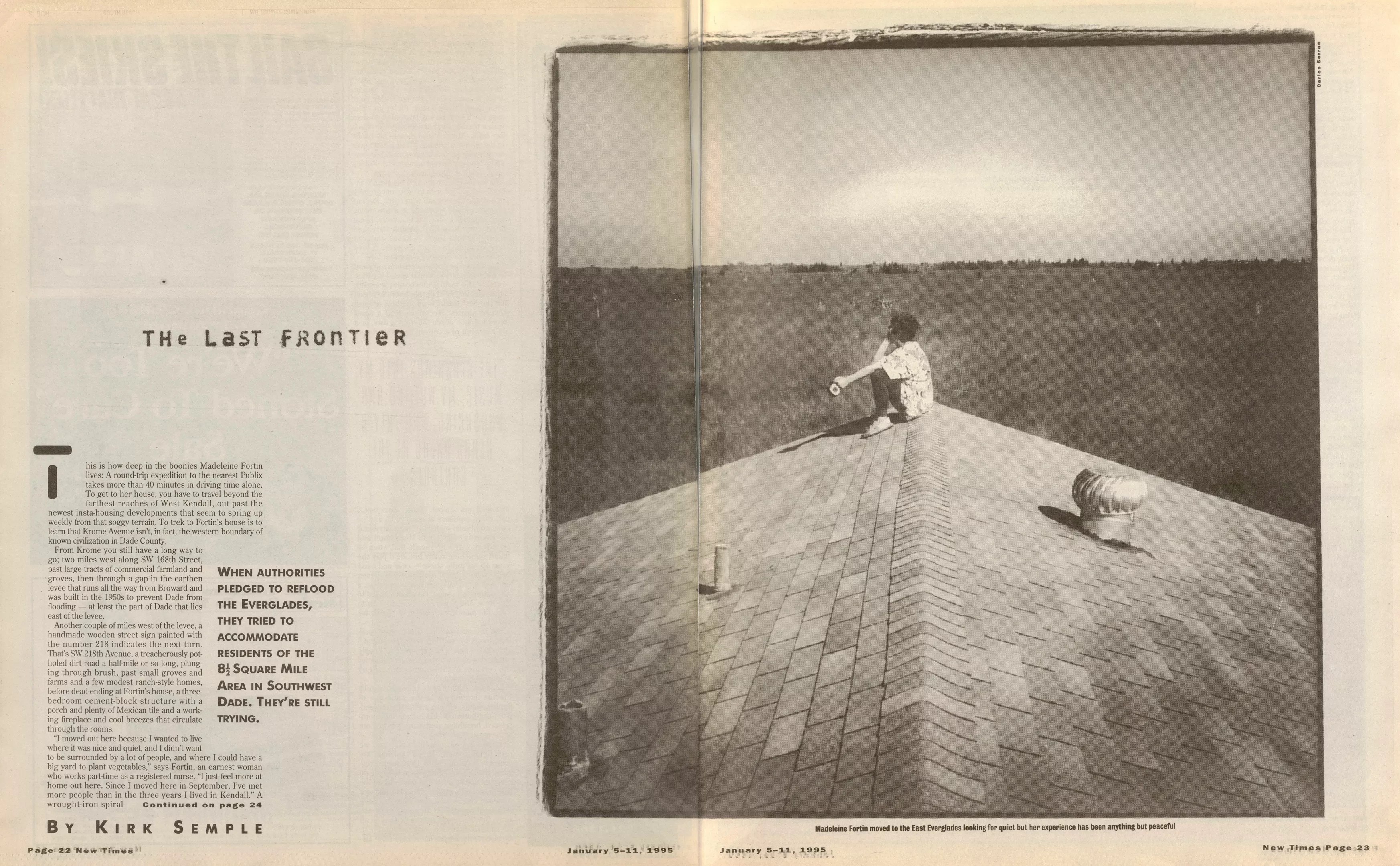
Opening spread for Kirk Semple’s “The Last Frontier,” from the January 5-11, 1995, issue of New Times.
Miami New Times image/Photo by Carlos Serrao
For “The Last Frontier,” the cover story in our first issue of 1995, staff writer Kirk Semple spent time on the outer edge of what was then called Dade County, getting to know residents of a parcel of land known as the 8-1/2 Square Mile Area.
The prosaic name, Semple wrote, designated what was at the time “the only residential ‘community’ in Dade that sits west of the earthen levee” that was built in the 1950s to prevent the county from flooding. “Bounded on the north and south by SW 104th and SW 168th streets, on the west by SW 221st Avenue, on the east by the levee, it’s a sparsely populated territory of chassis-bending dirt roads, inhabited by iconoclasts who have fled the congestion and urban ills of city life in the pioneering spirit of self-determination.”
Not surprisingly, the area was prone to flooding. Also, not surprisingly, residents resented governmental authorities big-footing around. To read the story now is fascinating, particularly in light of what has become of the western edge of Miami-Dade/eastern boundary of the Everglades. For perspective, here’s a recent satellite view of West Miami-Dade with the 8-1/2 Square Mile Area outlined in red.

A satellite view of the 8-1/2 Square Mile Area as we know it today
Google Maps
As for Kirk Semple, he left New Times in the late 1990s, relocating to South America to freelance. He joined the New York Times as a reporter in 2003 and is now based in Mexico City. The lead photo from “Dread Reckoning,” by Greg Baker, in the January 5-11, 1995, issue of New Times Miami New Times image/Photo by J.K. Yearick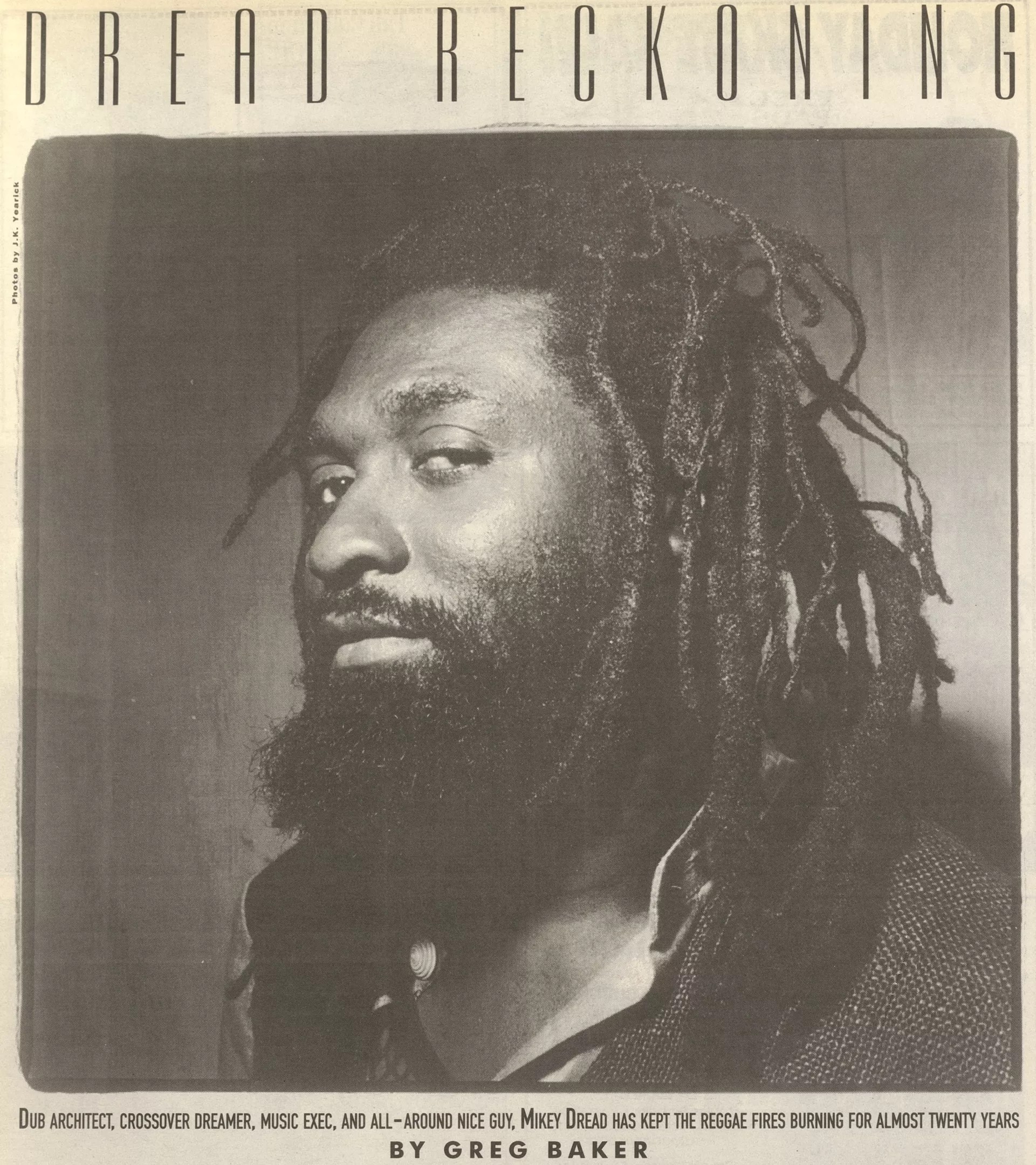
Greg Baker holds the distinction of being Miami New Times‘ first full-time staff writer. By early 1995, when he profiled famed reggae artist and DJ Mikey Dread (1954-2008), who’d moved to Miami two years earlier, Baker was well-ensconced as this paper’s music editor.
“In the West Indian-Caribbean-Jamaican enclave around North Miami’s 183rd Street, Mikey Dread is still considered a celebrity,” Baker wrote in “Dread Reckoning.” “He has edged his way into the spotlight often over the years, from his days as a radio star in Jamaica in the Seventies to his work with big-name British bands such as the Clash and UB40 at the beginning of the Eighties. His image was beamed into British homes when he narrated one series and produced another for Britain’s Channel 4 in 1981 and 1982. And albums have flowed from him all along, from 1979’s Dread at the Controls to 1993’s Obsession.”
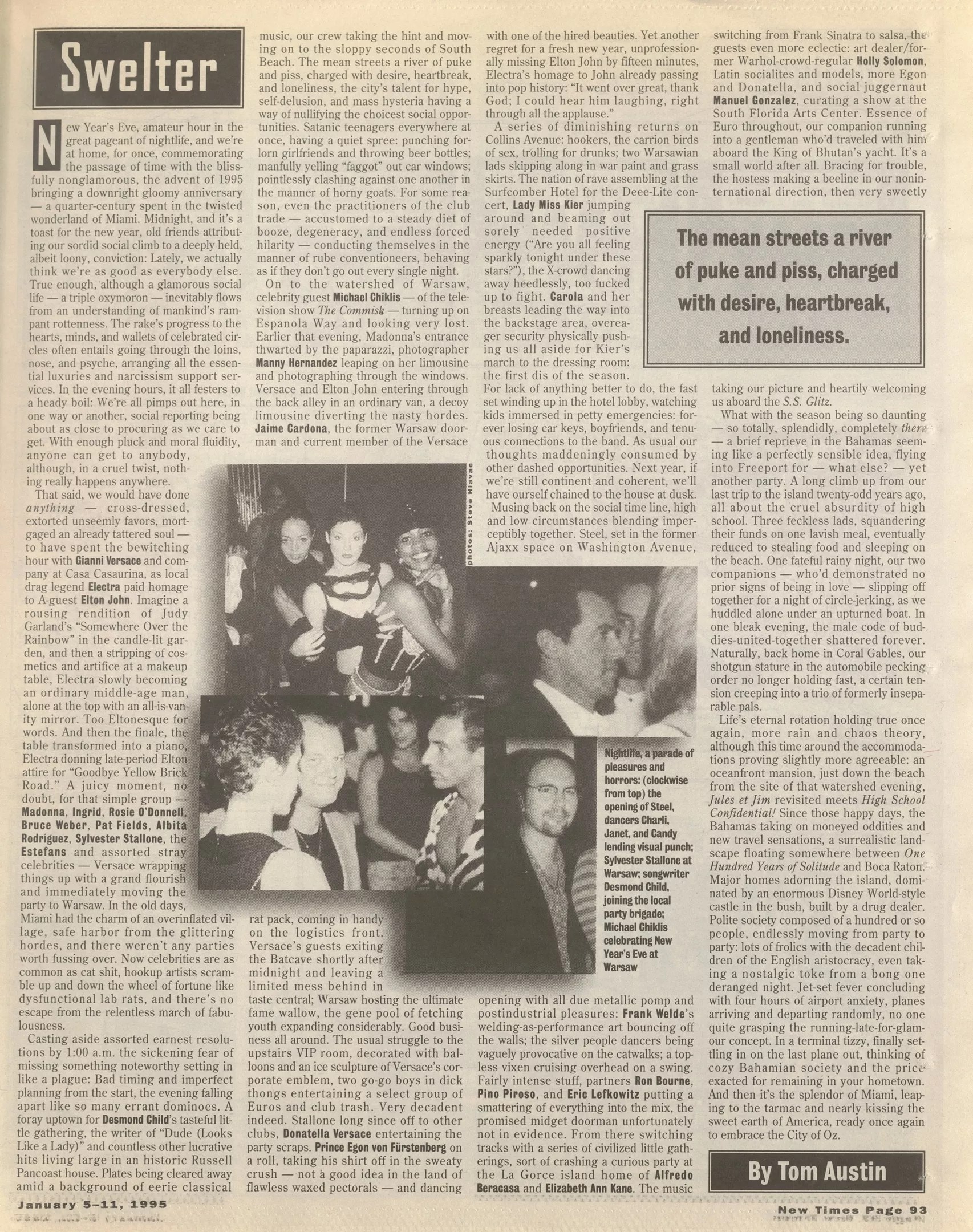
Tom Austin’s weekly “Swelter” column as it appeared in the January 5-11, 1995, issue of New Times
Miami New Times image/Photos by Steve Hlavac
For a chunk of the 1990s, the late Tom Austin covered Miami nightlife in his weekly “Swelter” column. The page above is the New Year’s Eve edition, chronicled as ’94 bled into ’95.
Choice snippet circa 1 a.m.: “A foray uptown for Desmond Child’s tasteful little gathering, the writer of ‘Dude (Looks Like a Lady)’ and countless other lucrative hits living large in a historic Russell Pancoast house. Plates being cleared away amid a background of eerie classical music, our crew taking the hint and moving on to the sloppy seconds of South Beach. The mean streets a river of puke and piss, charged with desire, heartbreak, and loneliness, the city’s talent for hype, self-delusion, and mass hysteria having a way of nullifying the choicest social opportunities.”

A one-sixth-page ad from the January 5-11, 1995, issue of New Times
Miami New Times image
A hemp clothing store ad from 1995. Evidently, the business didn’t last long. The more things change, the more they stay the same. A quarter-page ad from the January 5-11, 1995, issue of New Times. Miami New Times image
According to Miami-Dade property records, the Octagon was originally constructed in 1966. If that’s not a typo, the ad above must have signaled a significant redo.
Want to live there now? We’ve got your back. Asking price for a one bedroom on the fourth floor is $395,000. Two-bedrooms on the 11th and 12th floors are on the market for $455,000, and a larger two bedroom on the 16th floor can be had for an even $500,000.
According to the listings, the building is a zoned hotel, meaning 30-day rentals are kosher and soon short-term arrangements will be as well – but that’s pending compliance with new state condo-law reforms regarding special assessments.
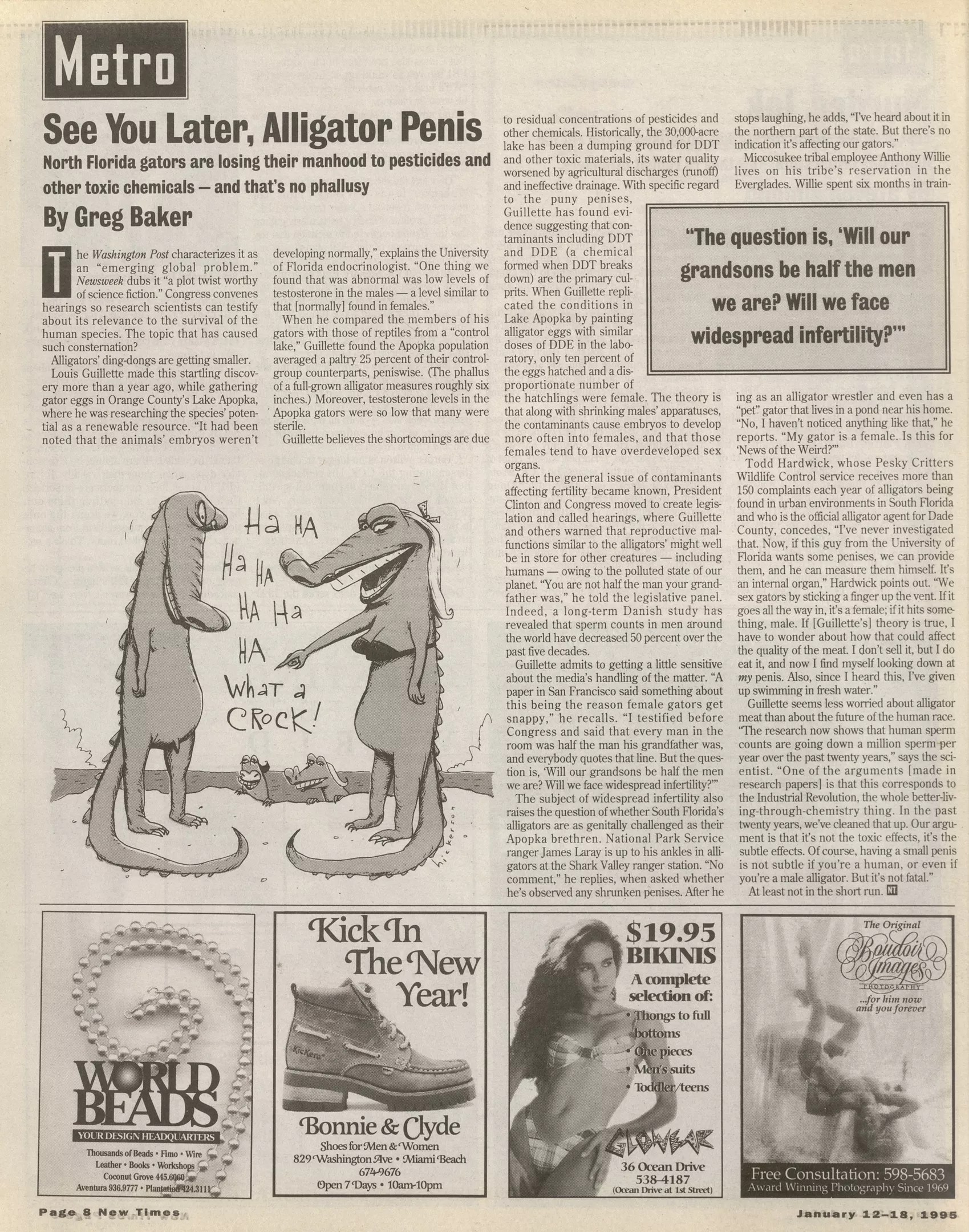
“See You Later, Alligator Penis,” on a page from the January 12-18, 1995, issue of New Times
Miami New Times image/Illustration by Buddy Hickerson
The fact that “See You Later, Alligator Penis” once appeared on top of a story practically demands that someone create a Headline Hall of Fame just to include this one, which tops a serious story by longtime New Times music editor Greg Baker. (The illustration, drawn by the estimable cartoonist Buddy Hickerson, is essential to the piece.) The University of Florida researcher Baker interviewed for the story, Louis Guillette, died at age 60 in 2015 – by which time his ongoing research on American alligators had made him world-famous.
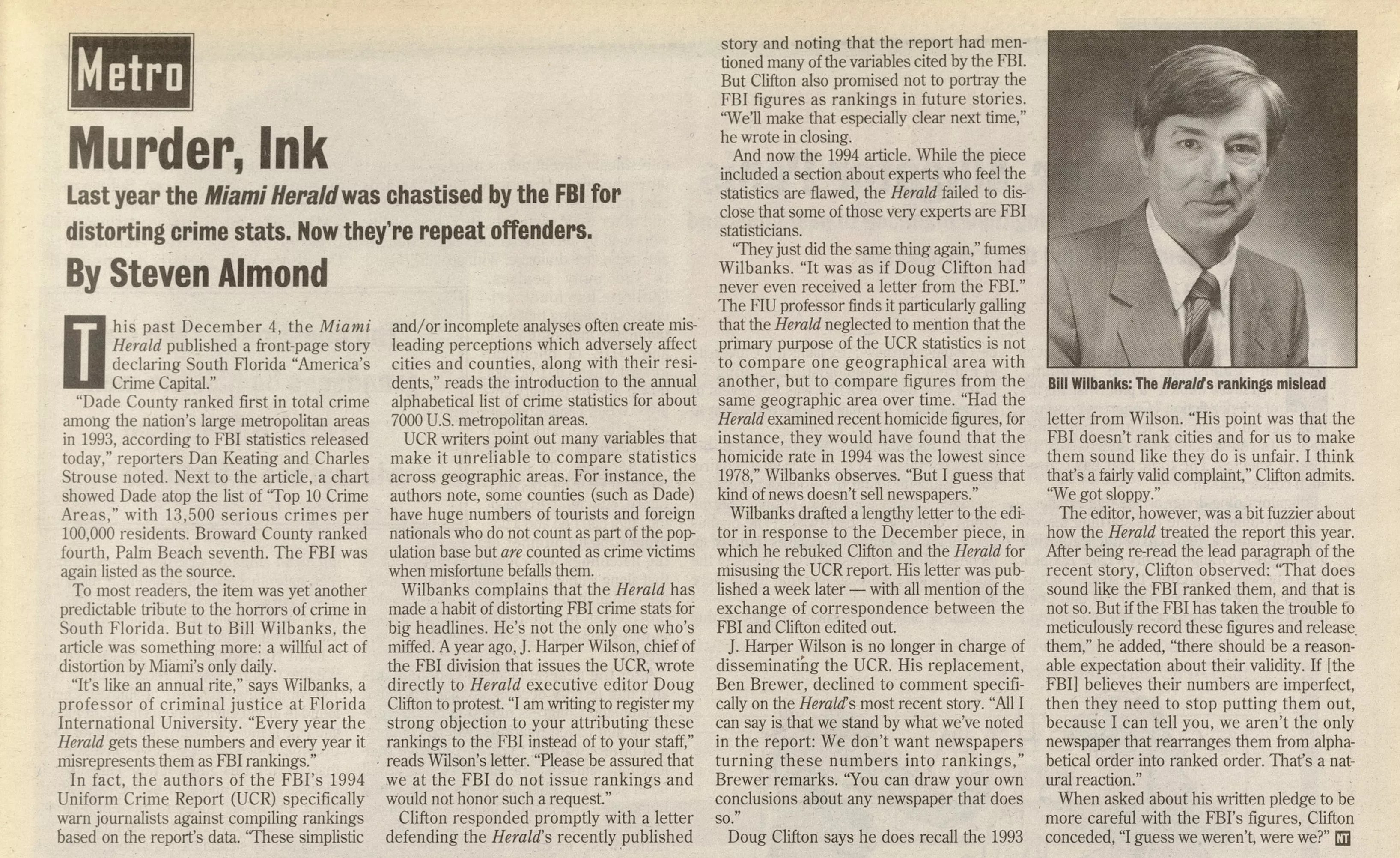
“Murder, Ink,” a short news item by Steve Almond, from the January 12-18, 1995, issue of New Times
Miami New Times image
New Times made it a point to cover local media – a beat mainstream outlets seldom, if ever, touched. “Murder, Ink,” a story by staff writer Steve Almond about the Miami Herald‘s sensationalist (and contextless) coverage of FBI crime statistics, is only one of many examples. This piece is among a small percentage of stories that are missing from our digital archive for reasons unknown, but a closer perusal of the above image reveals an Easter egg: The Herald story in question was co-bylined by “Charles Strouse,” who’d later jump from the Herald to New Times, where he went by Chuck. “The Pitt and the Pendulous,” a movie review by Todd Anthony, from the January 12-18, 1995, issue of New Times Miami New Times image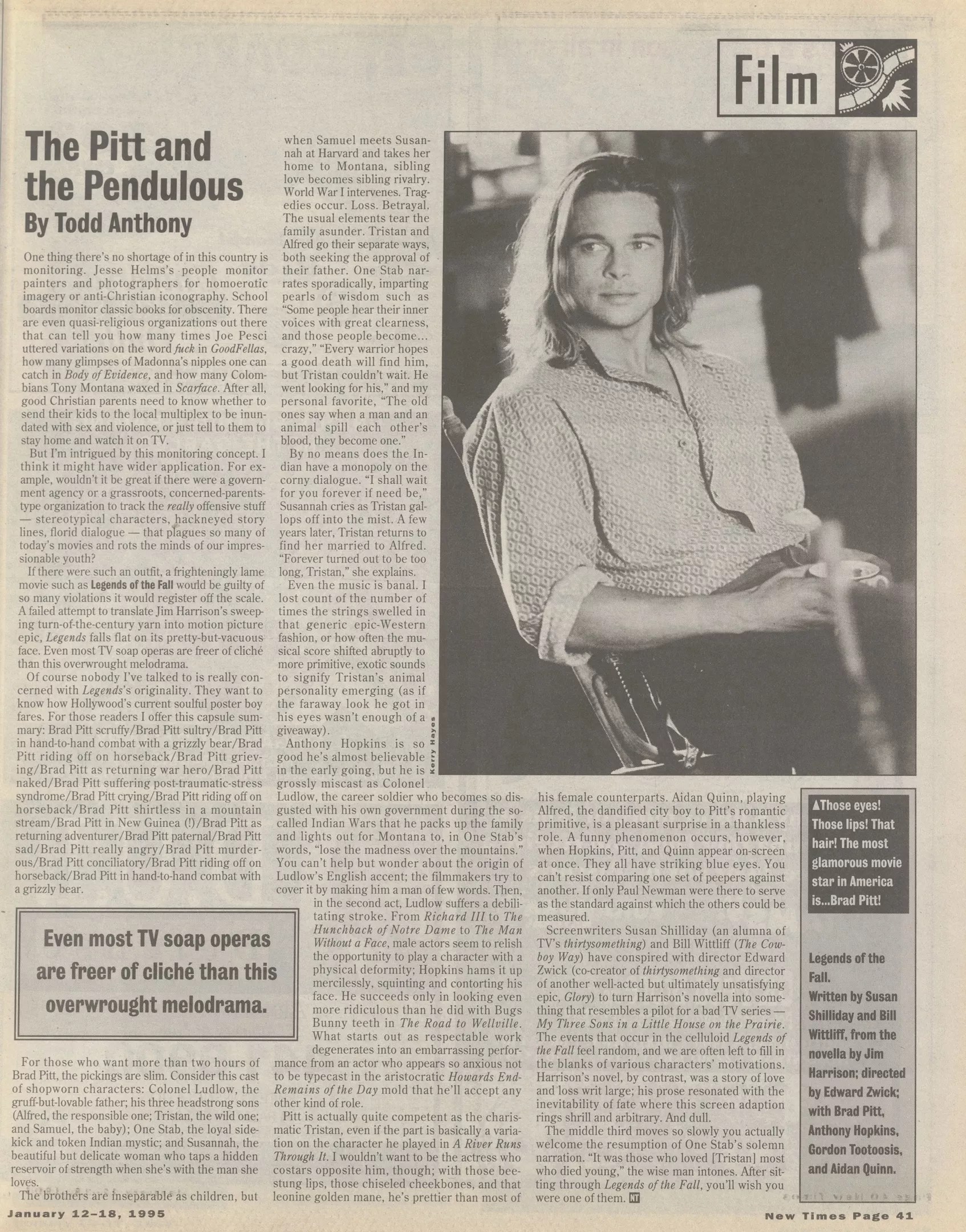
Staff writer/movie reviewer Todd Anthony was not impressed by Brad Pitt or his turn in Legends of the Fall.
“A failed attempt to translate Jim Harrison’s sweeping turn-of-the-century yarn into motion picture epic, Legends falls flat on its pretty-but-vacuous face. Even most TV soap operas are freer of cliché than this overwrought melodrama,” Anthony opined in “The Pitt and the Pendulous.” “Of course, nobody I’ve talked to is really concerned with Legends‘s originality. They want to know how Hollywood’s current soulful poster boy fares.”
(Too bad – Jim Harrison surely deserved better.)
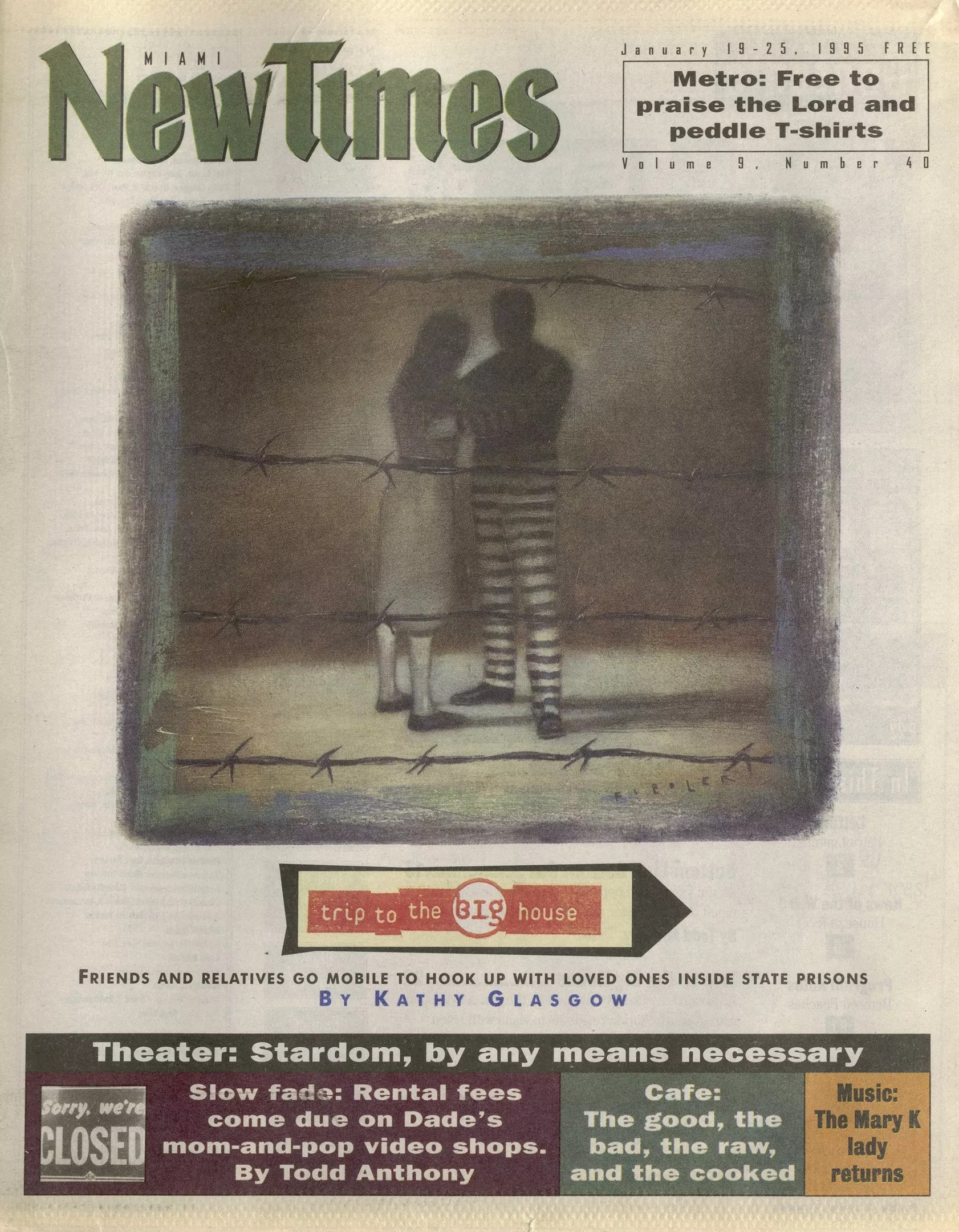
Cover of the January 19-25, 1995, issue of New Times
Miami New Times image/Illustration by Joseph Daniel Fiedler
The January 19-25, 1995, issue was a banger. Todd Anthony caught up with indie rocker Mary Karlzen (she’s still kicking it, BTW) and gave New Times readers nearly 4,000 words on the creeping demise of indie video rental shops, which were dying by suffocation at the hands of Blockbuster (a monopoly presided over by none other than Miami resident Wayne Huizenga). “‘Adult videos have become the last refuge of the mom-and-pops because Blockbuster doesn’t carry them,’ claims [Richard] Zeeman, referencing the imperious chain’s policy of not stocking any title rated NC-17 or worse,” Anthony wrote. “Which is to say, Debbie doesn’t do Dallas at Blockbuster. ‘My business swung from being a general title distributor with one or two adult films to now where it’s become 85 to 90 percent of my business.'”
Food critic Jen Karetnick ventured to North Beach to assay the sushi boat bar at then-newish Katana. “Propelled by a water pump, boats ferrying tempting little morsels (or, more precisely, pairs of morsels) parade past diners,” she wrote of Taka Furuya’s 71st Street spot. “You simply remove the cargo that tempts you. In the center’ island,’ Furuya watches the procession, cutting fish and shaping rice to replenish unloaded boats.” (Thirty years later, to the delight of loyal patrons, Katana’s boats still sail on.)
And then there was the January 19 cover story…
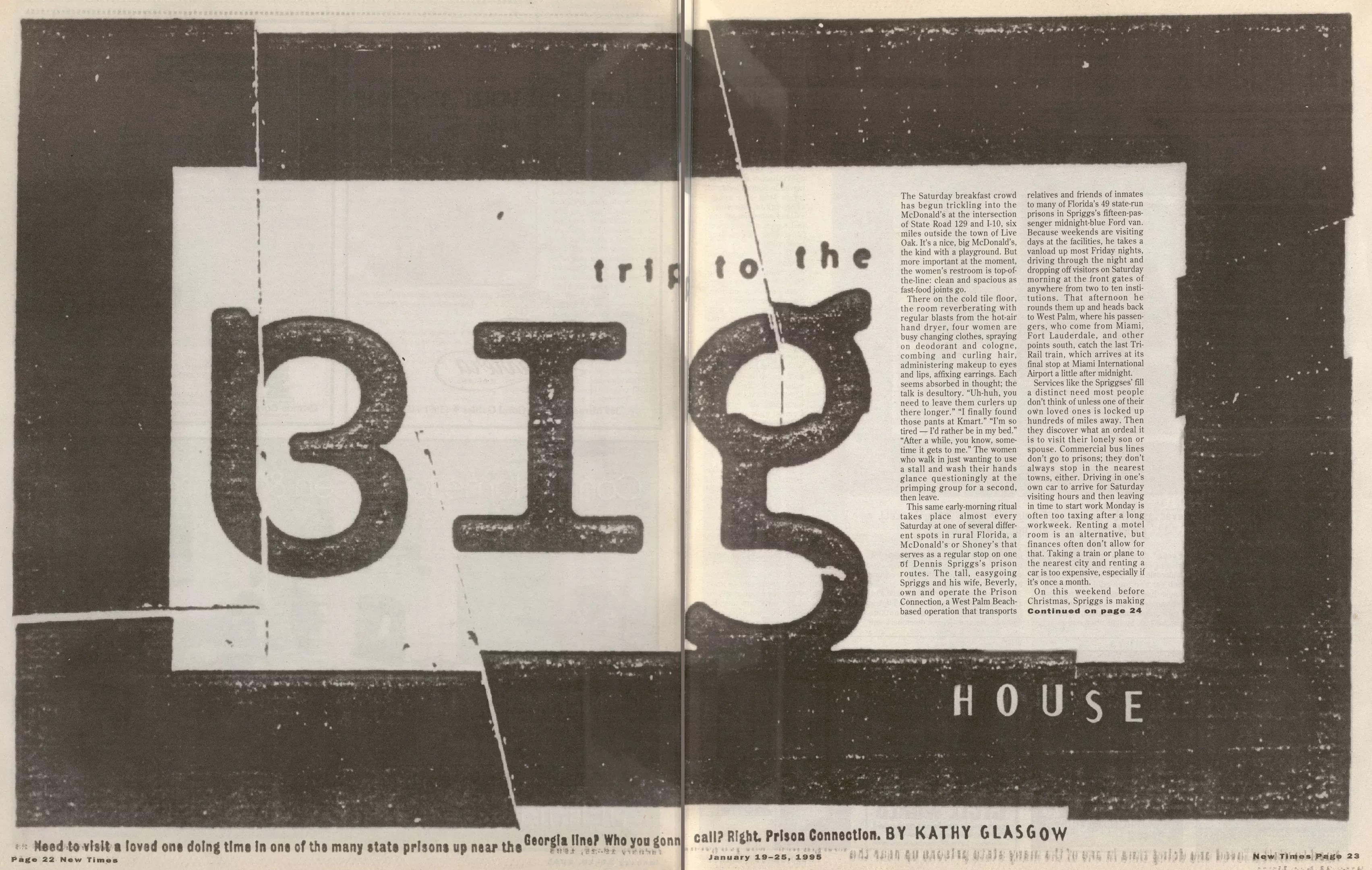
The two-page spread that opens Kathy Glasgow’s longform feature, “Trip to the Big House,” which appeared in the January 19-26, 1995, issue of New Times
Miami New Times image
During her decade at New Times, Kathy Glasgow justifiably earned a reputation for writing about communities that journalists seldom touched. “Trip to the Big House” is vintage Kathy Glasgow: She rode along on one of the bus trips offered by a company called Prison Connection, which ferried spouses and partners (mostly women) of incarcerated people (mostly men) to and from most of Florida’s four dozen correctional institutions to visit loved ones. After three decades, this story, which featured illustrations by Joseph Daniel Fiedler, remains a must-read.
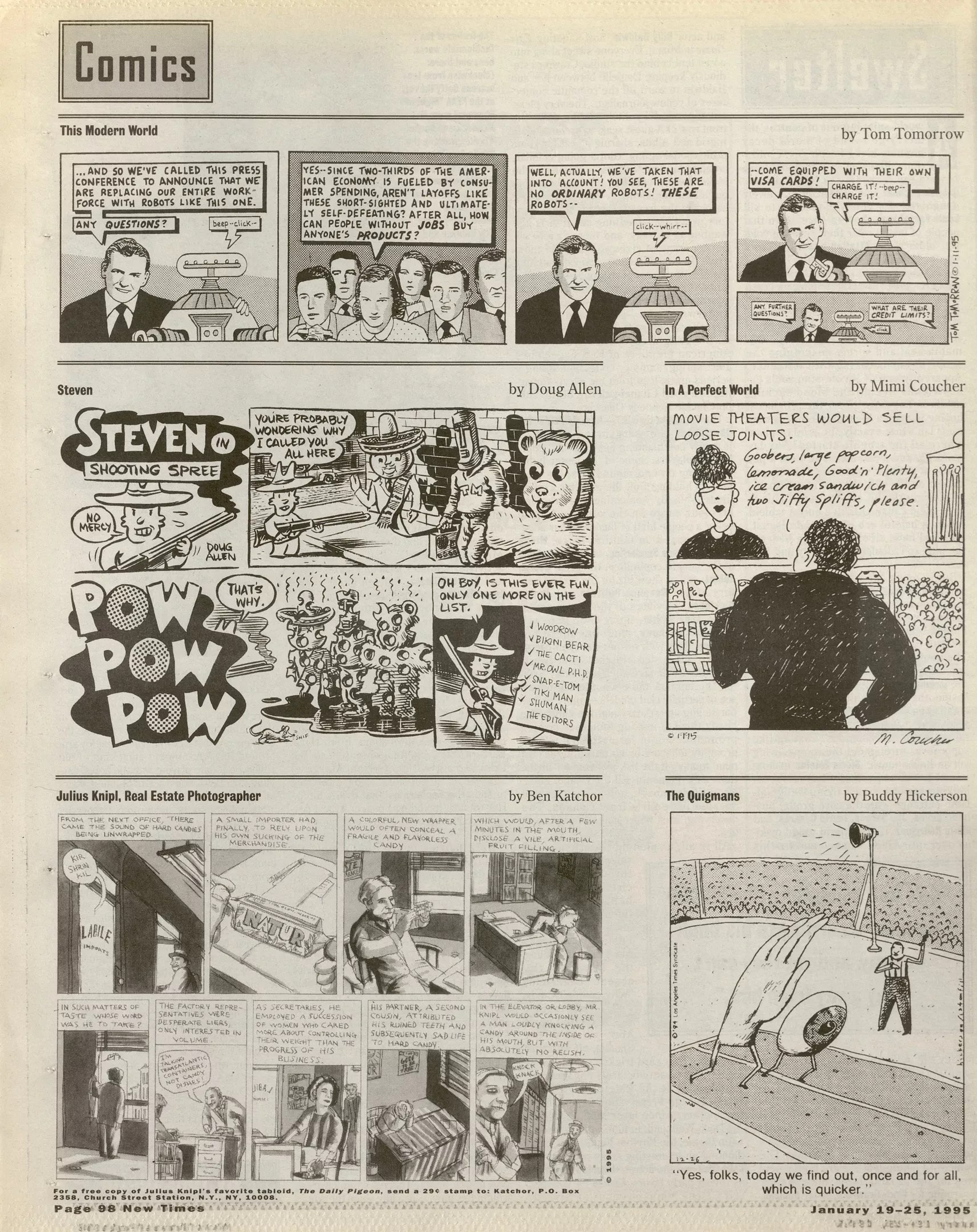
A full page of comics from the January 19-25 issue of New Times
Miami New Times image
An entire page of comics – those were the days! As noted higher up in this trip down memory lane, Buddy Hickerson also drew us the occasional story illustration. Tom Tomorrow‘s politically charged This Modern World was a staple of many an alt-weekly comics page, as was Doug Allen‘s decidedly underground Steven. Mimi Coucher (In a Perfect World) appears to be keeping an extremely low profile on today’s internet, per Google. Ben Katchor is simply and utterly brilliant. Julius Knipl, Real Estate Photographer was verbose as comic strips went, but it is more than worth a squint. Cover of the January 26-February 1, 1995, issue of New Times Miami New Times image/Illustration by Brian Stauffer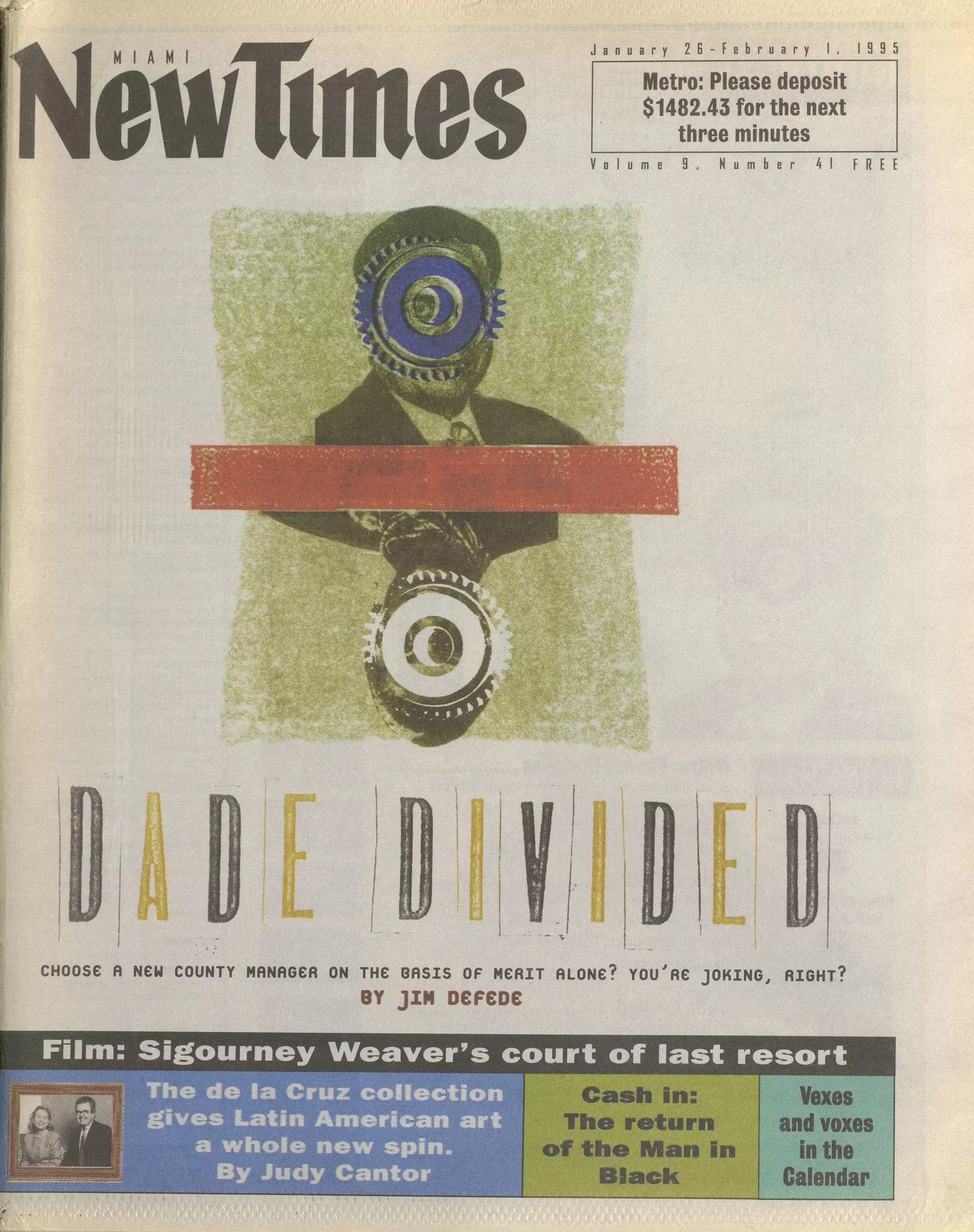
This brings us to the January 26-February 1 issue and a prescient piece by Jim DeFede, who, with four years in Miami under his belt, had thoroughly embedded himself in the region’s unique political universe. In “Dade Divided,” DeFede dissected a recently completed transfer of power in the county manager’s office. Appointed by a vote of the county commission, the post wound up pitting Armando Vidal, a Cuban American, against Cynthia Curry, who is Black. The commissioners went with Vidal.
“Dade Divided” should be required reading for anyone wishing to understand the evolution of Miami-Dade’s polarized political climate.
Bonus: Here’s a postscript DeFede wrote two years later after Vidal threatened to kick his ass. Also of note: Vidal was fired from his post in disgrace in 1998, then went on to serve as city manager of Hialeah for 25 years until he retired in 2023. And Curry? These days, she serves as city manager of Gainesville.)
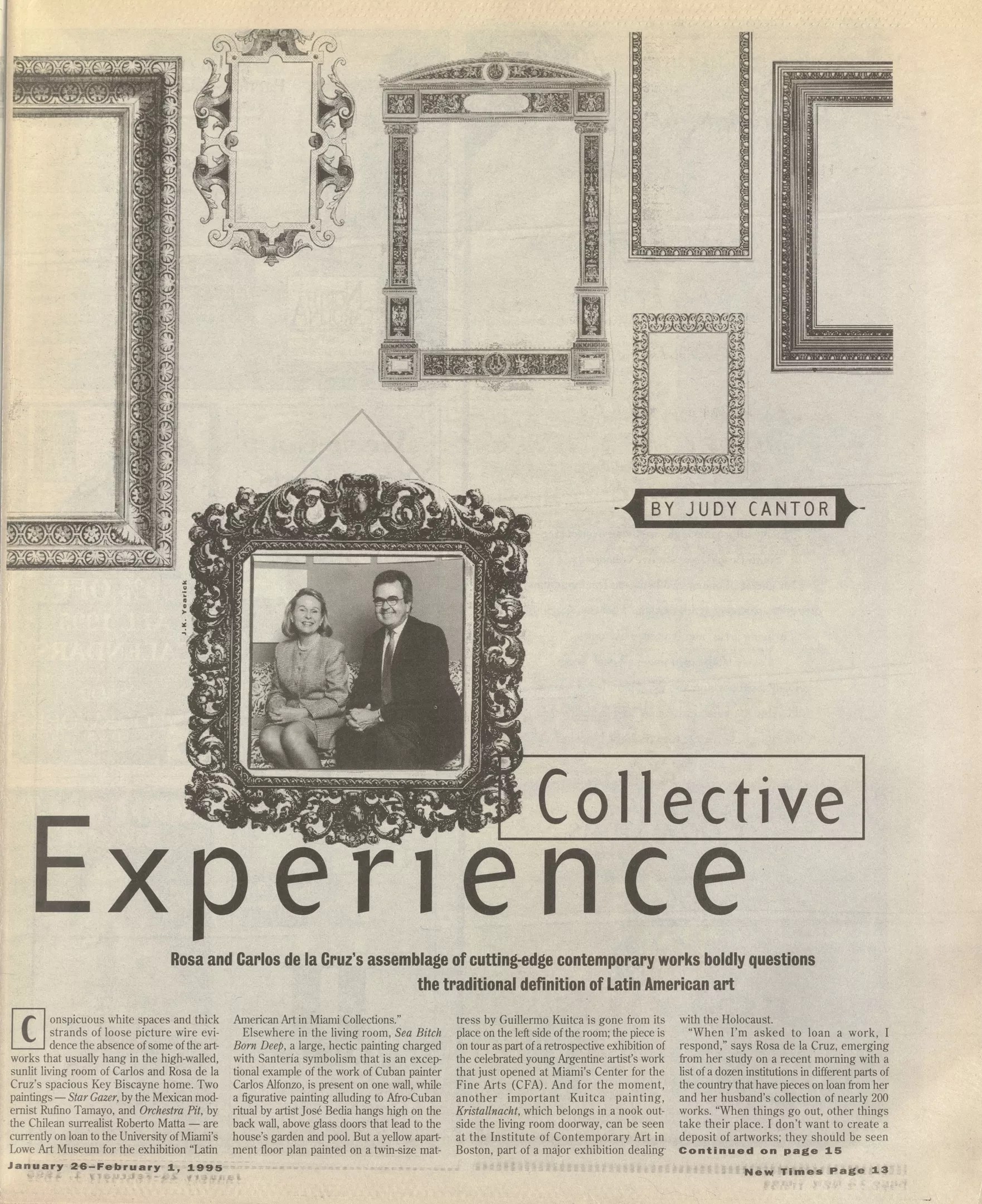
Judy Cantor’s profile of Rosa and Carlos de la Cruz, which appeared in the January 26-February 1, issue of New Times
Miami New Times image
The other long-form story in the January 26-February 1 issue was a profile of Cuban-American power couple Rosa and Carlos de la Cruz, brought to readers by staff writer Judy Cantor. Avid collectors of Latin-American art, the de la Cruzes had amassed a museum’s worth of works, some of which they’d loan out to actual museums. A decade and a half later, they’d open the de la Cruz Collection, a museum of their own in a building of their own in the Design District.
Rosa died in February 2024 at age 81. Shortly thereafter, Carlos auctioned off the collection and sold the building.
Cantor’s profile is missing from our digital archive, but you can click to read it here in its original print format: “Collective Experience.”

An ad for the Florida Lottery published in the January 26-February 1, 1995, issue of New Times
Miami New Times image